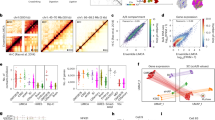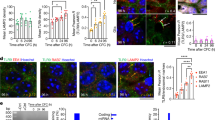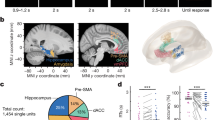Abstract
Throughout adulthood, new neurons are continuously added to the dentate gyrus, a hippocampal subregion that is important in spatial learning. Whether these adult-generated granule cells become functionally integrated into memory networks is not known. We used immunohistochemical approaches to visualize the recruitment of new neurons into circuits supporting water maze memory in intact mice. We show that as new granule cells mature, they are increasingly likely to be incorporated into circuits supporting spatial memory. By the time the cells are 4 or more weeks of age, they are more likely than existing granule cells to be recruited into circuits supporting spatial memory. This preferential recruitment supports the idea that new neurons make a unique contribution to memory processing in the dentate gyrus.
This is a preview of subscription content, access via your institution
Access options
Subscribe to this journal
Receive 12 print issues and online access
$209.00 per year
only $17.42 per issue
Buy this article
- Purchase on Springer Link
- Instant access to full article PDF
Prices may be subject to local taxes which are calculated during checkout






Similar content being viewed by others
References
Aimone, J.B., Wiles, J. & Gage, F.H. Potential role for adult neurogenesis in the encoding of time in new memories. Nat. Neurosci. 9, 723–727 (2006).
Cameron, H.A. & McKay, R.D. Adult neurogenesis produces a large pool of new granule cells in the dentate gyrus. J. Comp. Neurol. 435, 406–417 (2001).
Doetsch, F. & Hen, R. Young and excitable: the function of new neurons in the adult mammalian brain. Curr. Opin. Neurobiol. 15, 121–128 (2005).
Ming, G.L. & Song, H. Adult neurogenesis in the mammalian central nervous system. Annu. Rev. Neurosci. 28, 223–250 (2005).
Song, H. et al. New neurons in the adult mammalian brain: synaptogenesis and functional integration. J. Neurosci. 25, 10366–10368 (2005).
Overstreet-Wadiche, L.S. & Westbrook, G.L. Functional maturation of adult-generated granule cells. Hippocampus 16, 208–215 (2006).
Altman, J. & Das, G.D. Post-natal origin of microneurones in the rat brain. Nature 207, 953–956 (1965).
Hastings, N.B. & Gould, E. Rapid extension of axons into the CA3 region by adult-generated granule cells. J. Comp. Neurol. 413, 146–154 (1999).
van Praag, H. et al. Functional neurogenesis in the adult hippocampus. Nature 415, 1030–1034 (2002).
Zhao, C., Teng, E.M., Summers, R.G., Jr., Ming, G.L. & Gage, F.H. Distinct morphological stages of dentate granule neuron maturation in the adult mouse hippocampus. J. Neurosci. 26, 3–11 (2006).
Esposito, M.S. et al. Neuronal differentiation in the adult hippocampus recapitulates embryonic development. J. Neurosci. 25, 10074–10086 (2005).
Ge, S. et al. GABA regulates synaptic integration of newly generated neurons in the adult brain. Nature 439, 589–593 (2006).
Tashiro, A., Sandler, V.M., Toni, N., Zhao, C. & Gage, F.H. NMDA-receptor–mediated, cell-specific integration of new neurons in adult dentate gyrus. Nature 442, 929–933 (2006).
Shors, T.J. et al. Neurogenesis in the adult is involved in the formation of trace memories. Nature 410, 372–376 (2001).
Shors, T.J., Townsend, D.A., Zhao, M., Kozorovitskiy, Y. & Gould, E. Neurogenesis may relate to some but not all types of hippocampal-dependent learning. Hippocampus 12, 578–584 (2002).
Leuner, B., Gould, E. & Shors, T.J. Is there a link between adult neurogenesis and learning? Hippocampus 16, 216–224 (2006).
Snyder, J.S., Hong, N.S., McDonald, R.J. & Wojtowicz, J.M. A role for adult neurogenesis in spatial long-term memory. Neuroscience 130, 843–852 (2005).
Dupret, D. et al. Methylazoxymethanol acetate does not fully block cell genesis in the young and aged dentate gyrus. Eur. J. Neurosci. 22, 778–783 (2005).
Santarelli, L. et al. Requirement of hippocampal neurogenesis for the behavioral effects of antidepressants. Science 301, 805–809 (2003).
Nowakowski, R.S., Lewin, S.B. & Miller, M.W. Bromodeoxyuridine immunohistochemical determination of the lengths of the cell cycle and the DNA-synthetic phase for an anatomically defined population. J. Neurocytol. 18, 311–318 (1989).
Gage, F.H., Ray, J. & Fisher, L.J. Isolation, characterization and use of stem cells from the CNS. Annu. Rev. Neurosci. 18, 159–192 (1995).
Guzowski, J.F. et al. Mapping behaviorally relevant neural circuits with immediate-early gene expression. Curr. Opin. Neurobiol. 15, 599–606 (2005).
Teixeira, C.M., Pomedli, S.R., Maei, H.R., Kee, N. & Frankland, P.W. Involvement of the anterior cingulate cortex in the expression of remote spatial memory. J. Neurosci. 26, 7555–7564 (2006).
Kim, J.J. & Fanselow, M.S. Modality-specific retrograde amnesia of fear. Science 256, 675–677 (1992).
Takehara, K., Kawahara, S. & Kirino, Y. Time-dependent reorganization of the brain components underlying memory retention in trace eyeblink conditioning. J. Neurosci. 23, 9897–9905 (2003).
Clark, R.E., Broadbent, N.J. & Squire, L.R. Hippocampus and remote spatial memory in rats. Hippocampus 15, 260–272 (2005).
Martin, S.J., de Hoz, L. & Morris, R.G. Retrograde amnesia: neither partial nor complete hippocampal lesions in rats result in preferential sparing of remote spatial memory, even after reminding. Neuropsychologia 43, 609–624 (2005).
McNaughton, B.L., Barnes, C.A., Meltzer, J. & Sutherland, R.J. Hippocampal granule cells are necessary for normal spatial learning but not for spatially-selective pyramidal cell discharge. Exp. Brain Res. 76, 485–496 (1989).
Gould, E., Beylin, A., Tanapat, P., Reeves, A. & Shors, T.J. Learning enhances adult neurogenesis in the hippocampal formation. Nat. Neurosci. 2, 260–265 (1999).
Kempermann, G., Kuhn, H.G. & Gage, F.H. More hippocampal neurons in adult mice living in an enriched environment. Nature 386, 493–495 (1997).
van Praag, H., Kempermann, G. & Gage, F.H. Running increases cell proliferation and neurogenesis in the adult mouse dentate gyrus. Nat. Neurosci. 2, 266–270 (1999).
Kempermann, G., Kuhn, H.G. & Gage, F.H. Experience-induced neurogenesis in the senescent dentate gyrus. J. Neurosci. 18, 3206–3212 (1998).
Kempermann, G., Gast, D., Kronenberg, G., Yamaguchi, M. & Gage, F.H. Early determination and long-term persistence of adult-generated new neurons in the hippocampus of mice. Development 130, 391–399 (2003).
Schmidt-Hieber, C., Jonas, P. & Bischofberger, J. Enhanced synaptic plasticity in newly generated granule cells of the adult hippocampus. Nature 429, 184–187 (2004).
Wang, S., Scott, B.W. & Wojtowicz, J.M. Heterogenous properties of dentate granule neurons in the adult rat. J. Neurobiol. 42, 248–257 (2000).
Chawla, M.K. et al. Sparse, environmentally selective expression of Arc RNA in the upper blade of the rodent fascia dentata by brief spatial experience. Hippocampus 15, 579–586 (2005).
Guzowski, J.F. et al. Recent behavioral history modifies coupling between cell activity and Arc gene transcription in hippocampal CA1 neurons. Proc. Natl. Acad. Sci. USA 103, 1077–1082 (2006).
Zhang, W.P., Guzowski, J.F. & Thomas, S.A. Mapping neuronal activation and the influence of adrenergic signaling during contextual memory retrieval. Learn. Mem. 12, 239–247 (2005).
Lois, C. & Alvarez-Buylla, A. Long-distance neuronal migration in the adult mammalian brain. Science 264, 1145–1148 (1994).
Giese, K.P., Fedorov, N.B., Filipkowski, R.K. & Silva, A.J. Autophosphorylation at Thr286 of the alpha calcium-calmodulin kinase II in LTP and learning. Science 279, 870–873 (1998).
Jung, M.W. & McNaughton, B.L. Spatial selectivity of unit activity in the hippocampal granular layer. Hippocampus 3, 165–182 (1993).
Bruel-Jungerman, E., Davis, S., Rampon, C. & Laroche, S. Long-term potentiation enhances neurogenesis in the adult dentate gyrus. J. Neurosci. 26, 5888–5893 (2006).
Jessberger, S. & Kempermann, G. Adult-born hippocampal neurons mature into activity-dependent responsiveness. Eur. J. Neurosci. 18, 2707–2712 (2003).
Ramirez-Amaya, V., Marrone, D.F., Gage, F.H., Worley, P.F. & Barnes, C.A. Integration of new neurons into functional neural networks. J. Neurosci. 26, 12237–12241 (2006).
Frankland, P.W. & Bontempi, B. The organization of recent and remote memories. Nat. Rev. Neurosci. 6, 119–130 (2005).
Overstreet-Wadiche, L.S., Bensen, A.L. & Westbrook, G.L. Delayed development of adult-generated granule cells in dentate gyrus. J. Neurosci. 26, 2326–2334 (2006).
Becker, S. A computational principle for hippocampal learning and neurogenesis. Hippocampus 15, 722–738 (2005).
Wiskott, L., Rasch, M.J. & Kempermann, G. A functional hypothesis for adult hippocampal neurogenesis: avoidance of catastrophic interference in the dentate gyrus. Hippocampus 16, 329–343 (2006).
Magavi, S.S., Mitchell, B.D., Szentirmai, O., Carter, B.S. & Macklis, J.D. Adult-born and preexisting olfactory granule neurons undergo distinct experience-dependent modifications of their olfactory responses in vivo. J. Neurosci. 25, 10729–10739 (2005).
Coggeshall, R.E. & Lekan, H.A. Methods for determining numbers of cells and synapses: a case for more uniform standards of review. J. Comp. Neurol. 364, 6–15 (1996).
Acknowledgements
We thank S. Josselyn for comments on this manuscript. This work was supported by grants from the Canadian Institutes of Health Research and the EJLB Foundation (P.W.F.). N.K. and A.H.W. were supported by Hospital for Sick Children Restracomp awards. C.M.T. received support from the Graduate Program in Areas of Basic and Applied Biology and the Portuguese Foundation for Science and Technology.
Author information
Authors and Affiliations
Contributions
P.W.F., N.K. and C.M.T. conceived the experiments. C.M.T., P.W.F. and A.H.W. conducted the water maze studies, N.K. and C.M.T. conducted the immunohistochemistry and quantification and C.M.T. conducted the statistical analyses. PW.F. supervised the project and wrote the paper.
Corresponding author
Ethics declarations
Competing interests
The authors declare no competing financial interests.
Supplementary information
Supplementary Fig. 1
Induction of Fos and Arc is limited to neurons following behavior testing. (PDF 662 kb)
Supplementary Fig. 2
Induction of Fos in the dentate gyrus neurons following water maze training and testing. (PDF 62 kb)
Supplementary Fig. 3
Performance of mice across multiple probe tests. (PDF 66 kb)
Supplementary Fig. 4
Preferential recruitment of adult-generated neurons from the innermost layers of the dentate gyrus into spatial memory networks. (PDF 72 kb)
Supplementary Fig. 5
Vast majority of BrdU+ cells are neuronal 10 weeks following BrdU treatment. (PDF 465 kb)
Supplementary Fig. 6
Induction of Arc in BrdU+ cells. (PDF 437 kb)
Supplementary Fig. 7
One-week-old granule cells are not transiently recruited into spatial memory networks. (PDF 151 kb)
Rights and permissions
About this article
Cite this article
Kee, N., Teixeira, C., Wang, A. et al. Preferential incorporation of adult-generated granule cells into spatial memory networks in the dentate gyrus. Nat Neurosci 10, 355–362 (2007). https://doi.org/10.1038/nn1847
Received:
Accepted:
Published:
Issue Date:
DOI: https://doi.org/10.1038/nn1847
This article is cited by
-
Role of mucin glycosylation in the gut microbiota-brain axis of core 3 O-glycan deficient mice
Scientific Reports (2023)
-
Effect of soluble amyloid precursor protein-alpha on adult hippocampal neurogenesis in a mouse model of Alzheimer’s disease
Molecular Brain (2022)
-
Interactions Among Brain-Derived Neurotrophic Factor and Neuroimmune Pathways Are Key Components of the Major Psychiatric Disorders
Molecular Neurobiology (2022)
-
Formation and integration of new neurons in the adult hippocampus
Nature Reviews Neuroscience (2021)
-
Hippocampal neural stem cells and microglia response to experimental inflammatory bowel disease (IBD)
Molecular Psychiatry (2021)



